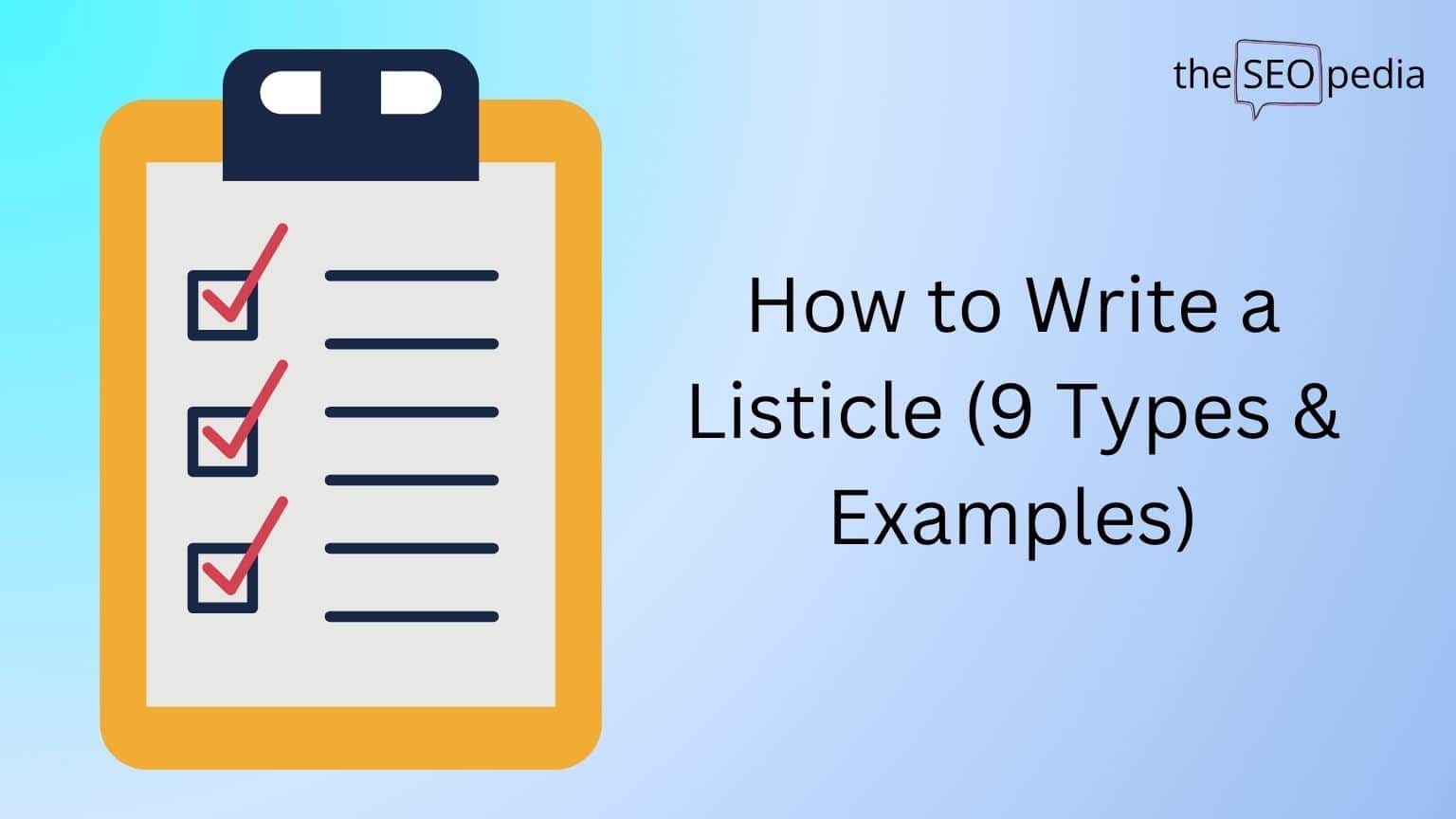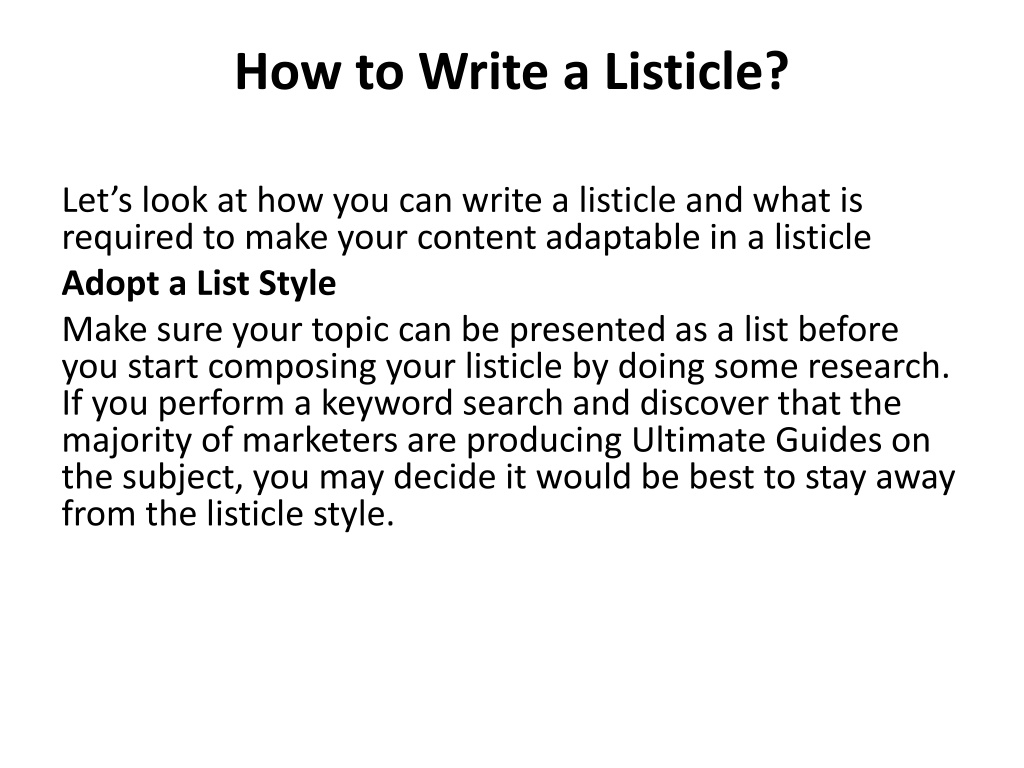The Anatomy of a Successful Listicle
A well-crafted listicle is a powerful tool for engaging readers and conveying information in a concise and easily digestible format. When it comes to learning how to write a listicle, it’s essential to understand the key elements that make this type of content effective. A catchy title, concise language, and relevant examples are all crucial components of a successful listicle.
A listicle’s title should be attention-grabbing and accurately reflect the content of the article. This is often the first thing readers will see, and it can make or break their decision to continue reading. When crafting a title, consider using action verbs, questions, or statements that create curiosity. For example, “10 Ways to Boost Your Productivity” or “The Top 5 Mistakes to Avoid When Starting a New Business.”
Concise language is also vital when writing a listicle. Readers are often looking for quick and easy-to-understand information, so it’s essential to get straight to the point. Avoid using overly complex sentences or jargon that may confuse or intimidate readers. Instead, focus on using simple language that is easy to understand and relate to.
Relevant examples are another critical component of a successful listicle. These can help to illustrate key points, make the content more engaging, and provide readers with a better understanding of the topic. When selecting examples, choose ones that are relevant, timely, and interesting. This will help to keep readers engaged and invested in the content.
By incorporating these key elements, you can create a listicle that is both informative and engaging. Whether you’re writing about how to write a listicle or any other topic, remember to keep your title catchy, your language concise, and your examples relevant. This will help you to craft a piece of content that resonates with readers and provides value to your audience.
Choosing a Topic that Resonates with Your Audience
When it comes to learning how to write a listicle, one of the most critical steps is selecting a topic that resonates with your target audience. A well-chosen topic can make all the difference in engaging readers and conveying your message effectively. So, how do you choose a topic that aligns with your audience’s interests and needs?
The first step is to understand your audience. Who are they? What are their pain points? What are their interests? What problems do they want to solve? By understanding your audience, you can identify topics that are relevant and timely. Conducting surveys, analyzing social media conversations, and reading industry reports can help you gain insights into your audience’s needs and interests.
Brainstorming is another essential step in choosing a topic. Take some time to think about the topics that are relevant to your audience. Use mind mapping, free writing, or listing techniques to generate ideas. Consider topics that are trending, topics that are evergreen, and topics that are unique and innovative.
Researching your topic is also crucial. Use online tools such as Google Trends, Keyword Planner, and social media to research your topic. Look for topics that have a high search volume, topics that are being discussed on social media, and topics that are relevant to your audience’s interests.
Once you have a list of potential topics, evaluate them based on their relevance, timeliness, and uniqueness. Choose a topic that aligns with your audience’s interests and needs, and that provides value and usefulness to the reader. By choosing a topic that resonates with your audience, you can create a listicle that engages readers and conveys your message effectively.
Some popular topic ideas for listicles include “top 10” lists, “how-to” guides, and “tips and tricks” articles. These types of articles are popular because they provide value and usefulness to the reader, and are easy to consume and understand. By choosing a topic that fits into one of these categories, you can create a listicle that is engaging, informative, and effective.
Developing a Clear and Concise Writing Style
When it comes to learning how to write a listicle, developing a clear and concise writing style is crucial. A well-written listicle should be easy to read, understand, and engage with. To achieve this, it’s essential to use simple language, active voice, and bullet points.
Simple language is key to writing a clear and concise listicle. Avoid using complex sentences, jargon, or technical terms that may confuse or intimidate readers. Instead, use short sentences, active voice, and everyday language that is easy to understand. For example, instead of saying “The utilization of bullet points can facilitate a more efficient reading experience,” say “Using bullet points makes it easier to read and understand the content.”
Active voice is another essential element of clear and concise writing. It makes the writing more engaging, easier to read, and more effective in conveying the message. For example, instead of saying “The listicle was written by a team of experts,” say “A team of experts wrote the listicle.”
Bullet points are also a great way to make the content more scannable, readable, and engaging. They help to break up the text, highlight key points, and make the content more digestible. When using bullet points, make sure to keep them concise, clear, and consistent. For example, instead of saying “Here are some benefits of using bullet points,” say “Benefits of using bullet points include:
- Improved readability
- Increased engagement
- Enhanced scannability
By using simple language, active voice, and bullet points, you can develop a clear and concise writing style that engages readers and conveys your message effectively. Remember, the goal of a listicle is to provide value and usefulness to the reader, so make sure to keep the content focused, informative, and easy to understand.
Additionally, consider using transitional phrases, headings, and subheadings to make the content more readable and scannable. Transitional phrases help to connect the ideas, headings and subheadings help to organize the content, and make it easier to read and understand.
Creating a Logical and Easy-to-Follow Structure
When it comes to learning how to write a listicle, creating a logical and easy-to-follow structure is crucial. A well-organized listicle should be easy to read, understand, and navigate. To achieve this, it’s essential to use headings, subheadings, and transitions to guide the reader through the content.
Headings and subheadings help to break up the content, highlight key points, and provide a clear hierarchy of information. They also help to make the content more scannable, readable, and engaging. When using headings and subheadings, make sure to keep them concise, clear, and consistent. For example, instead of saying “The Benefits of Using Listicles,” say “Benefits of Listicles” and use a subheading like “Increased Engagement” or “Improved Readability.”
Transitions are also essential in creating a logical and easy-to-follow structure. They help to connect the ideas, provide a smooth flow of information, and make the content more readable. When using transitions, make sure to use words like “however,” “in addition,” “meanwhile,” and “finally” to connect the ideas and provide a clear flow of information.
A logical and easy-to-follow structure also involves organizing the content in a way that makes sense. For example, if you’re writing a listicle on “10 Ways to Improve Your Writing Skills,” you should start with the most important or relevant point and work your way down to the least important or relevant point. This will help to keep the reader engaged and interested in the content.
Additionally, consider using bullet points, numbered lists, and short paragraphs to make the content more readable and scannable. Bullet points and numbered lists help to break up the content, highlight key points, and provide a clear hierarchy of information. Short paragraphs help to make the content more readable, scannable, and engaging.
By creating a logical and easy-to-follow structure, you can make your listicle more readable, scannable, and engaging. Remember, the goal of a listicle is to provide value and usefulness to the reader, so make sure to keep the content focused, informative, and easy to understand.
Using Attention-Grabbing Headlines and Subheadlines
When it comes to learning how to write a listicle, crafting attention-grabbing headlines and subheadlines is crucial. A well-written headline can make or break the success of your listicle, as it determines whether readers will click on your article and engage with your content.
A good headline should be informative, yet attention-grabbing. It should accurately reflect the content of your listicle and entice readers to keep reading. To craft a compelling headline, consider using action verbs, questions, or statements that create curiosity. For example, “10 Ways to Boost Your Productivity” or “The Top 5 Mistakes to Avoid When Starting a New Business.”
Subheadlines are also essential in breaking up the content and providing a clear hierarchy of information. They should be concise, clear, and consistent, and should provide additional context to the headline. For example, “Discover the secrets to increasing your productivity and achieving your goals” or “Learn how to avoid common mistakes and set your business up for success.”
When writing headlines and subheadlines, consider the following tips:
- Keep it concise: Aim for headlines and subheadlines that are 5-7 words in length.
- Use action verbs: Verbs like “boost,” “increase,” and “improve” can help to create a sense of urgency and encourage readers to take action.
- Ask questions: Questions like “Are you struggling to…” or “Do you want to…” can help to create curiosity and encourage readers to click on your article.
- Use numbers: Numbers like “10 Ways” or “5 Tips” can help to create a sense of specificity and encourage readers to engage with your content.
By crafting attention-grabbing headlines and subheadlines, you can increase the visibility and engagement of your listicle, and encourage readers to share your content with others.
Adding Visual Interest with Images and Graphics
When it comes to learning how to write a listicle, adding visual interest with images and graphics is a crucial step. Visuals can help to break up the text, make the content more engaging, and convey complex information in a more easily digestible format.
Images and graphics can be used to illustrate key points, provide examples, and add visual interest to the listicle. They can also help to create a more professional and polished look, making the content more shareable and engaging.
When selecting images and graphics, consider the following tips:
- Use high-quality images: Avoid using low-resolution or pixelated images, as they can detract from the overall quality of the listicle.
- Choose relevant images: Select images that are relevant to the topic and help to illustrate key points.
- Use graphics to break up text: Graphics can be used to break up large blocks of text and make the content more scannable.
- Optimize images for search engines: Use keywords in the image file name and alt tag to help search engines understand the content of the image.
Some popular types of visuals that can be used in a listicle include:
- Infographics: Infographics can be used to present complex information in a visually appealing format.
- Photos: Photos can be used to illustrate key points and add visual interest to the listicle.
- Illustrations: Illustrations can be used to create a more playful and engaging tone.
- Charts and graphs: Charts and graphs can be used to present data and statistics in a clear and concise format.
By incorporating images and graphics into your listicle, you can make the content more engaging, shareable, and effective in conveying your message.
Optimizing Your Listicle for Search Engines
When it comes to learning how to write a listicle, optimizing your content for search engines is a crucial step. By incorporating keywords, meta descriptions, and optimizing images, you can increase the visibility and ranking of your listicle in search engine results.
Keywords are an essential component of search engine optimization (SEO). They help search engines understand the content and relevance of your listicle. When selecting keywords, consider the following tips:
- Use relevant keywords: Choose keywords that are relevant to the topic and content of your listicle.
- Use long-tail keywords: Long-tail keywords are more specific and less competitive than generic keywords.
- Use keywords in the title and meta description: Include keywords in the title and meta description to help search engines understand the content and relevance of your listicle.
Meta descriptions are also important for SEO. They provide a brief summary of the content and help search engines understand the relevance of your listicle. When writing a meta description, consider the following tips:
- Keep it concise: Meta descriptions should be no more than 160 characters.
- Use keywords: Include keywords in the meta description to help search engines understand the content and relevance of your listicle.
- Make it compelling: Use action verbs and questions to make the meta description compelling and enticing.
Optimizing images is also important for SEO. By including keywords in the image file name and alt tag, you can help search engines understand the content and relevance of your listicle. When optimizing images, consider the following tips:
- Use keywords in the image file name: Include keywords in the image file name to help search engines understand the content and relevance of your listicle.
- Use keywords in the alt tag: Include keywords in the alt tag to help search engines understand the content and relevance of your listicle.
- Use descriptive text: Use descriptive text to provide context and help search engines understand the content and relevance of your listicle.
By incorporating keywords, meta descriptions, and optimizing images, you can increase the visibility and ranking of your listicle in search engine results.
Editing and Refining Your Listicle for Maximum Impact
When it comes to learning how to write a listicle, editing and refining your content is a crucial step. By reviewing and revising your listicle, you can ensure that it is error-free, engaging, and effective in conveying your message.
Editing involves reviewing your listicle for grammar, punctuation, and spelling errors. It also involves checking for consistency in formatting, headings, and style. When editing your listicle, consider the following tips:
- Use a style guide: Use a style guide, such as the AP Stylebook or the Chicago Manual of Style, to ensure consistency in formatting and style.
- Check for grammar and punctuation errors: Use a grammar and punctuation checker, such as Grammarly or ProWritingAid, to catch errors and improve your writing.
- Read your listicle aloud: Reading your listicle aloud can help you catch errors and improve the flow of your writing.
Refining your listicle involves reviewing and revising your content to ensure that it is engaging and effective. When refining your listicle, consider the following tips:
- Use clear and concise language: Use simple language and avoid jargon or technical terms that may confuse your readers.
- Use active voice: Using active voice can make your writing more engaging and easier to read.
- Use bullet points and headings: Using bullet points and headings can help to break up your content and make it easier to read.
By editing and refining your listicle, you can ensure that it is error-free, engaging, and effective in conveying your message. Remember, the goal of a listicle is to provide value and usefulness to the reader, so make sure to keep your content focused, informative, and easy to understand.
Additionally, consider getting feedback from others, such as colleagues or peers, to help you refine and improve your listicle. This can help you catch errors and improve the overall quality of your content.







